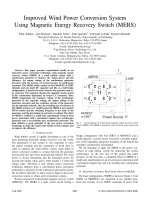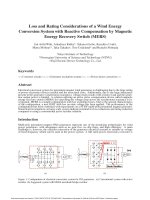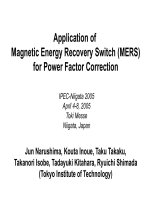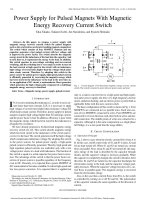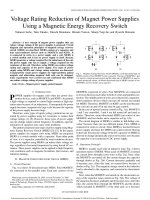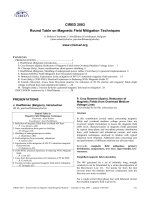Magnetic surveying...
Bạn đang xem bản rút gọn của tài liệu. Xem và tải ngay bản đầy đủ của tài liệu tại đây (5.8 MB, 103 trang )
9/25/2016
MAGNETIC - TRUONG QUOC THANH
1
Introduction
Magnetic surveying…
Investigation on the basis of anomalies in the Earth´s
magnetic field resulting from the magnetic properties of
the underlying rocks (magnetic susceptibility and
remanence)
9/25/2016
MAGNETIC - TRUONG QUOC THANH
2
Application
• Exploration of fossil fuels (oil, gas, coal)
• Exploration of ore deposits
• Regional and global tectonics
• Large scale geological structures, volcanology
• Buried conductive objects (cables, drums)
• Unexploded ordnance (UXO)
• Archaeological investigations
• Engineering/construction site investigation
9/25/2016
MAGNETIC - TRUONG QUOC THANH
3
Structure of the lecture
1.
2.
3.
4.
5.
Equations in magnetic surveying
Geomagnetic field (refresher)
Magnetic properties of rocks (refresher)
Survey strategies and interpretation
Conclusions
We will talk about magnetic properties at an atomic
scale, paleomagnetics or the magnetic structure of the
Earth. These notions were developed last year. We will
focus on magnetics for environmental and engineering
applications and emphasize links with gravimetry.
9/25/2016
MAGNETIC - TRUONG QUOC THANH
4
1. Equations in magnetic
surveying
• Like a lot of phenomena in Physics, understanding magnetism
requires an understanding of quantum theory, but perhaps more
than most.
• We’ll need to get into this a bit, but there are some useful ideas we
can discuss without going too deeply.
• Scientists first investigating magnetism noticed a lot of similarities
between magnetic fields and electrical fields, and so presumed they
were due to the same physical mechanism.
• In fact, Gauss proposed that Coulomb’s law for the forces between
electrical charges could be modified for magnetic force, except that
the property eo, the electrical permittivity, is replaced by something
called the magnetic permeability - mo.
9/25/2016
MAGNETIC - TRUONG QUOC THANH
5
1. Equations in magnetic
surveying
Thus, the electric force:
1 Q1Q2
F
4 o r 2
becomes the magnetic force
o P1P2
F
4 r 2
µ0 =4π*10-7 H/m
Where P1 and P2 are called magnetic poles. The main
difference is that the magnetic field always looks like there
are two poles of opposite sign in some proximity to each
other, but as far as we know the concept of a magnetic pole
is a pure fiction.
9/25/2016
MAGNETIC - TRUONG QUOC THANH
6
1. Equations in magnetic
surveying
The field of a magnetic pole
These ideas cannot be transferred directly to magnetism,
because magnetic poles do not really exist. Nevertheless,
many magnetic properties can be described and magnetic
problems solved in terms of fictitious poles. For example,
we can define a magnetic field B as the force exerted by a
pole of strength p on a unit pole at distance r.
o P
B
2
4 r
9/25/2016
MAGNETIC - TRUONG QUOC THANH
7
1. Equations in magnetic
surveying
The potential of a magnetic pole
In studying gravitation we also used the concept of a field to
describe the region around a mass in which its attraction could be
felt by another test mass. In order to move the test mass away from
the attracting mass, work had to be done against the attractive force
and this was found to be equal to the gain of potential energy of the
test mass. When the test mass was a unit mass, the attractive force
was called the gravitational field and the gain in potential energy
was called the change in potential.
We can define the magnetic potential W at a distance r from a pole
of strength p
9/25/2016
MAGNETIC - TRUONG QUOC THANH
8
1. Equations in magnetic
surveying
The magnetic dipole
9/25/2016
The potential W at a distance r from the
midpoint of the pair of poles, in a
direction that makes an angle to the axis,
is the sum of the potentials of the
positive and negative poles. At the point
(r, θ) the distances from the respective
poles are r+ and r– and we get for the
magnetic potential of the pair
MAGNETIC - TRUONG QUOC THANH
9
surveying
The magnetic dipole
The pair of opposite poles is considered to
form a dipole when their separation becomes
infinitesimally small compared to the distance
to the point of observation (i.e., d « r). In this
case, we get the approximate relations
When d « r, we can write and terms of order
(d/r)2 and higher can be neglected. This leads to
the further simplifications
Substituting gives the dipole potential at the
point (r, θ):
9/25/2016
MAGNETIC - TRUONG QUOC THANH
10
surveying
The magnetic dipole
The quantity m(dp) is called the magnetic moment of the dipole.
This definition derives from observations on bar magnets. The
torque exerted by a magnetic field to turn the magnet parallel to the
field direction is proportional to m. This applies even when the
separation of the poles becomes very small, as in the case of the
dipole.
9/25/2016
MAGNETIC - TRUONG QUOC THANH
11
2. Geomagnetic field
9/25/2016
MAGNETIC - TRUONG QUOC THANH
12
2. Geomagnetic field
The total field vector, B, has a vertical
component Z and a horizontal component
H in the direction of magnetic north.
•Inclination = Dip of B.
•Declination = angle between magnetic
north and true north.
B varies in strength from 25,000 nT in
equatorial regions to 70,000 nT at the
poles.
9/25/2016
MAGNETIC - TRUONG QUOC THANH
13
2. Geomagnetic field
More complex than the gravity field:
irregular variations with latitude,
longitude and time
Inclination varies depending on
the hemisphere
Geocentric dipole is inclined at
about 11.4°
9/25/2016
MAGNETIC - TRUONG QUOC THANH
14
2. Geomagnetic field
The magnetic pole is
moving in time
9/25/2016
MAGNETIC - TRUONG QUOC THANH
15
2. Geomagnetic field
Declination: Then and Now
9/25/2016
MAGNETIC - TRUONG QUOC THANH
16
2. Geomagnetic field
Declination: Then and Now
9/25/2016
MAGNETIC - TRUONG QUOC THANH
17
2. Geomagnetic field
US/UK world magnetic chart – Epoch 2000
Declination – Main
9/25/2016
MAGNETIC - TRUONG QUOC THANH
18
2. Geomagnetic field
US/UK world magnetic chart – Epoch 2000
Inclination – Main
9/25/2016
MAGNETIC - TRUONG QUOC THANH
19
2. Geomagnetic field
9/25/2016
MAGNETIC - TRUONG QUOC THANH
20
2. Geomagnetic field
Migration of the North Pole
9/25/2016
MAGNETIC - TRUONG QUOC THANH
21
2. Geomagnetic field
Origin of the geomagnetic field
Magnetic field of the Earth measured at the surface comes from
three sources:
97-99% Main field generated by dynamo action in the outer core
1-2% External field generated in space in the magnetosphere
1-2% Crustal field from remnant magnetization above the Curie depth
Main field varies significantly with time scale of years (secular variation)
External field varies with time scales of minutes to days
Crustal field on varies over geological time scales
At any point the magnetic field is defined by the magnetic field elements
Magnetic field is more complicated in spatial form than gravity field
9/25/2016
MAGNETIC - TRUONG QUOC THANH
22
2. Geomagnetic field
Origin of the geomagnetic field
Not a remanent origin (temperature too high).
Dynamo action produced by the circulation of charged particles in
couples convective cells within the outer, fluid, part of the Earth's
core.
The secular variation, and alignment of dipole
with rotation axis, suggest that the magnetic
field originates in the relatively rapid fluid
motion in a part of the Earth with a high
electrical conductivity.
9/25/2016
MAGNETIC - TRUONG QUOC THANH
23
2. Geomagnetic field
External component of the
Earth’s magnetic field
From 50-1500 km above the Earth’s surface
is the ionosphere, a region of plasma with
high electrical conductivity.
Changing magnetic fields from the
magnetosphere can induce large electric
currents in the ionosphere.
Changes in these currents produce large
changes in the magnetic field measured at
the Earth’s surface.
9/25/2016
The external component of the
magnetic field is generated in the
atmosphere and magnetosphere.
The solar wind (a stream of H and
He ions) is deflected by the Earths
internal magnetic field to create the
magnetosphere.
The interactions between the solar
wind and the Earth’s magnetic field
are very complex.
Temporal changes in the solar
wind, due to sunspots, solar flares
and coronal mass ejections can
produce a change in the magnetic
field at the surface of the Earth.
MAGNETIC - TRUONG QUOC THANH
24
2. Geomagnetic field
External component of the Earth’s magnetic field
When the solar wind is in a steady
state, the Earth’s magnetic field shows
a daily variation that is due to the
Earth turning within the current
systems of the magnetosphere and
ionosphere. The typical variation is
called the solar quiet day variation
(Sq). The amplitude is typical 10-20
nT and varies with latitude. Clearly
seen in time series above.
When the solar wind is active, the Earth’s magnetic field is said to be disturbed. Magnetic
storms occur when the current systems change over a period of several days and the field at the
Earth’s surface can change by 100’s of nanotesla. These changes are largest beneath major
ionospheric current systems. A small substorm can be seen in the middle of the time series plotted
above.
Smaller magnetic field disturbances are classified as substorms and bays and have timescales of
several hours.
Solar activity is characterized by an 11 year cycle and we are currently in a minimum.
Maximum solar activity results in high levels of activity in the Earth’s external magnetic field and
frequent magnetic storms and strong auroral displays.
9/25/2016
MAGNETIC - TRUONG QUOC THANH
25


